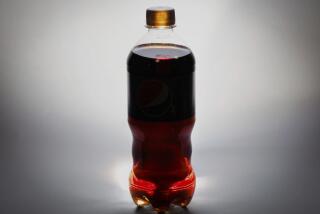Still searching for the perfect sugar stand-in
- Share via
After 40 years, science has yet to resolve one of America’s biggest dietary dilemmas -- finding an alternative to sugar.
It’s not for lack of trying or lack of a market. Some 30% of Americans are obese, a national weight problem expected to fuel an increased demand for substitute sweeteners that began when the first diet products appeared in the 1960s.
The U.S. surgeon general has called obesity an epidemic, and more than 163 million Americans already eat reduced-calorie or sugar-free foods, making artificial sweeteners a $1-billion-a-year industry.
The problem is that no artificial sweetener has quite the taste or versatility of sugar. “There’s going to be opportunities for something new, and I think anything new is going to need a selling point, an advantage over what’s now available,” said Sara Risch, a chemist and consultant on sweeteners.
The ideal sugar replacement would be stable enough to be baked and frozen, cheap enough to be mass produced, safe for public consumption, mix well with water and remain effective if stored for long periods. Researchers also say a new sweetener must activate the right taste receptors on the tongue -- including one yet to be discovered. “It’s like buying a lottery ticket, you have to hit all five or six numbers to win big,” said Eric Walters, a former chemist at the Nutrasweet Co., who now teaches biochemistry at the Chicago Medical School.
The bumps on your tongue, called papillae, contain taste buds made up of dozens of taste cells. When these cells encounter molecules that give off flavors, they trigger a range of nerve signals to the brain. A food’s taste is determined by the sensations created by the taste cells -- and enhanced by chemicals that create odors detected by olfactory neurons in the nose.
Humans can sense four basic tastes: sweet, sour, bitter and salty. (Sometimes a fifth is included, called umami, the Japanese term for a savory, delicious taste.)
Sweetness may be the most difficult to simulate. Although humans have up to 20 different types of receptors for bitter flavors -- possibly to warn us from poisons -- we have only two sweet-flavor receptors.
Last summer, researchers at Mount Sinai Medical Center in New York found that while sugar and artificial sweeteners activate the same taste receptor, known as T-1R3, there is an unknown receptor somewhere on the tongue that’s activated by sugar alone. That’s the objective of taste scientists today.
“There are several people chasing it, but right now there are no leads,” said Sami Damak, a molecular biologist and taste researcher who worked on the Mount Sinai study.
Walk into any coffee shop and you’ll find packets of two or three artificial sweeteners that come close to sugar but can’t duplicate its flavor. Aspartame is found in Equal, Sweet’N Low is a saccharin product and Splenda is made by bonding the sugar molecule sucralose with chlorine. These substitutes also are available under lesser-known brand names.
All three have advocates and critics. Fans say they all help with weight loss, but others complain about aftertastes and possible long-term health effects.
“Sugar remains the gold standard,” said Lyn Nabors, a spokeswoman for the artificial sweetening industry.
Nabors said the trend in the industry was to combine different sweeteners in diet foods and beverages to enhance the taste. But a real sugar replacement remains an elusive, time-consuming and expensive goal.
Researchers may spend more than $1 million on a product before they approach federal regulators for approval, experts say. And the products don’t always work or prove practical.
Gilbert V. Levin, a Beltsville, Md.-based research scientist, spent years on a sucrose-based substitute that tasted just like sugar -- but cost $3,000 a pound. “You’re not going to sell much at that price,” he said.
Most experts agree that the science of how taste buds interact with foods has come a long way. “Our theory of taste has evolved,” said Levin, founder and chairman of Spherix, which markets a new sweetener called X, used in 7-Eleven’s diet Slurpees.
Several of today’s popular sweeteners were accidents. Aspartame, for example, was invented in 1965 when a researcher working on an ulcer medication at Searle Laboratories noticed a sweet taste when he licked his finger. The granddaddy of sugar substitutes was discovered in 1878 by Johns Hopkins University chemists Ira Remsen and Constantine Fahlberg. They were working on preservatives and linked the sweetness in something Fahlberg later ate to a chemical residue that turned out to be saccharin.
Like any food additive, sweeteners must be approved by the Food and Drug Administration -- a stringent review process that can take more than a decade. It took 15 years to approve aspartame. Levin patented Tagatose, now in cola-flavored Slurpees, in 1988, but the government didn’t approve it for foods and beverages until late 2001.
Experts say reviews are necessary. “It’s much more difficult to get a food additive approved than a new drug, which in some ways makes sense,” Walters said. “A drug is taken under a doctor’s care, but you can’t accept any risk with a food additive.”






